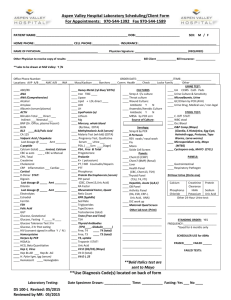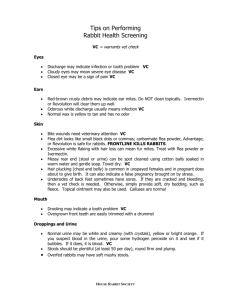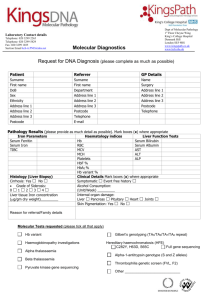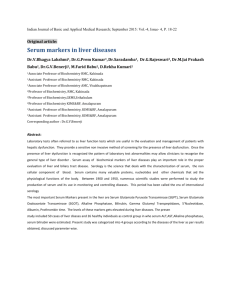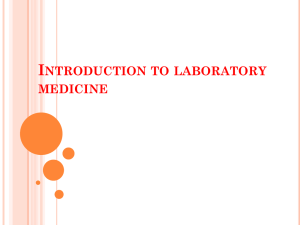Chapter 3: Clinical Biochemistry and Hematology
advertisement
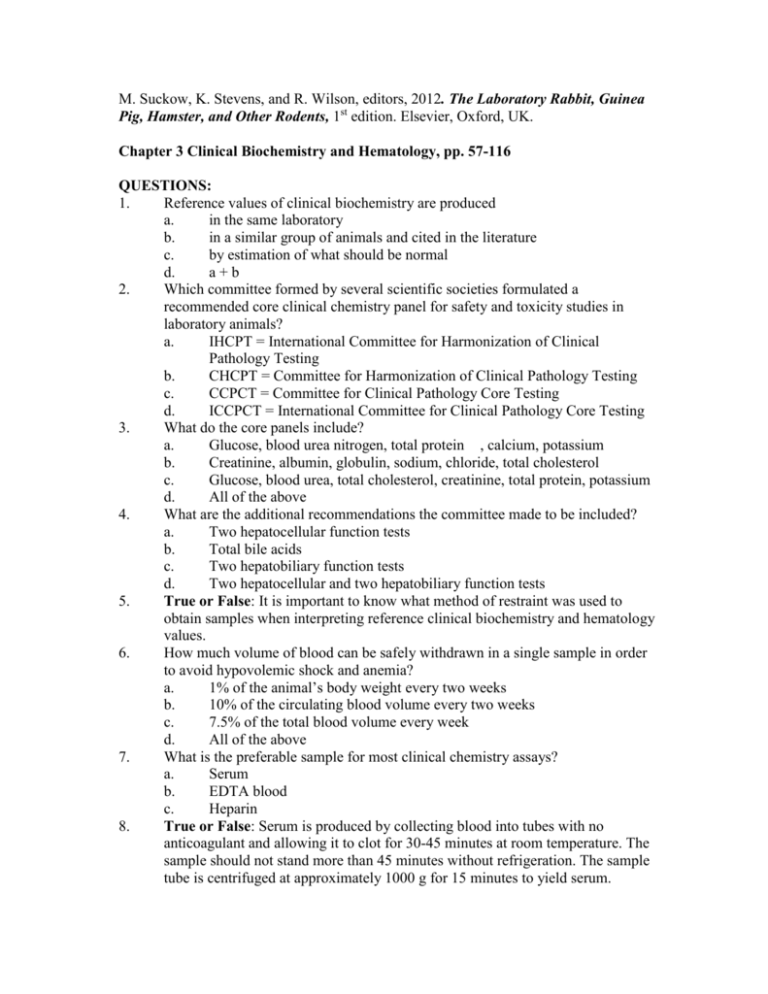
M. Suckow, K. Stevens, and R. Wilson, editors, 2012. The Laboratory Rabbit, Guinea Pig, Hamster, and Other Rodents, 1st edition. Elsevier, Oxford, UK. Chapter 3 Clinical Biochemistry and Hematology, pp. 57-116 QUESTIONS: 1. Reference values of clinical biochemistry are produced a. in the same laboratory b. in a similar group of animals and cited in the literature c. by estimation of what should be normal d. a+b 2. Which committee formed by several scientific societies formulated a recommended core clinical chemistry panel for safety and toxicity studies in laboratory animals? a. IHCPT = International Committee for Harmonization of Clinical Pathology Testing b. CHCPT = Committee for Harmonization of Clinical Pathology Testing c. CCPCT = Committee for Clinical Pathology Core Testing d. ICCPCT = International Committee for Clinical Pathology Core Testing 3. What do the core panels include? a. Glucose, blood urea nitrogen, total protein , calcium, potassium b. Creatinine, albumin, globulin, sodium, chloride, total cholesterol c. Glucose, blood urea, total cholesterol, creatinine, total protein, potassium d. All of the above 4. What are the additional recommendations the committee made to be included? a. Two hepatocellular function tests b. Total bile acids c. Two hepatobiliary function tests d. Two hepatocellular and two hepatobiliary function tests 5. True or False: It is important to know what method of restraint was used to obtain samples when interpreting reference clinical biochemistry and hematology values. 6. How much volume of blood can be safely withdrawn in a single sample in order to avoid hypovolemic shock and anemia? a. 1% of the animal’s body weight every two weeks b. 10% of the circulating blood volume every two weeks c. 7.5% of the total blood volume every week d. All of the above 7. What is the preferable sample for most clinical chemistry assays? a. Serum b. EDTA blood c. Heparin 8. True or False: Serum is produced by collecting blood into tubes with no anticoagulant and allowing it to clot for 30-45 minutes at room temperature. The sample should not stand more than 45 minutes without refrigeration. The sample tube is centrifuged at approximately 1000 g for 15 minutes to yield serum. 9. 10. 11. 12. 13. 14. 15. 16. 17. 18. 19. 20. Which two factors interfere with the results of the clinical biochemistry assays? a. Lipemia and glicemia b. Glicemia and hemolysis c. Lipemia and hemolysis d. Uremia and hemolysis True or False: The method and site of sample collection may also affect resulting values What are the methods of urine collection for many small laboratory animals? a. Spontaneous urination b. Manual bladder compression c. Cystocentesis and catheterization d. All of the above True or False: The simplest method of urine analysis is performed with a commercial dry reagent test strip, or dipstick, which requires only a few microliters of urine per test reagent square and provides semi quantified measures of urine components. Which procedure do you follow to analyze the urine sediment under the microscope for cells, bacteria and crystals? a. Centrifuge 1-2 ml of urine at 10 000 g for 10 minutes b. Place some drops of urine on dipstick c. Cannot be evaluated due to small volume of urine True or False: A decrease in glucose concentration by approximately 7% is reported in blood that sits at room temperature for 1 hour. Which are the primary lipids in the serum that are commonly measured in laboratory animals? a. Cholesterol and fatty acids b. Phospholipids and triglycerides c. Cholesterol and triglycerides d. Cholesterol and phospholipids Which is the precipitating agent that is often used to remove lipoproteins from the serum sample? a. Heparin b. Citrate c. EDTA d. Polyethylene glycol 6000 True or False: Fasting prior to obtaining blood samples for accurate Cholesterol assays is not required. What are the correct functions of low-density and high-density lipoproteins? a. Low-density carry cholesterol from the liver throughout the body, and high-density lipoproteins carry cholesterol away from the tissues of the body back to the liver b. Low-density and high-density lipoproteins carry the cholesterol away from the tissues of the body back to the liver True or False: Triglycerides are a major component of very low-density lipoprotein and serve as a source of energy. What is the standardized method that represents enzyme activity? 21. 22. 23. 24. 25. 26. 27. 28. 29. 30. 31. a. International units b. Microliter c. Mg/dl What is the definition of IU? a. One unit is the amount of enzyme that reacts with one picomole of substrate per minute. b. One unit is the amount of enzyme that reacts with one picomole of substrate per second. c. One unit is the amount of enzyme that reacts with one gram of substrate per minute. When are alkaline phosphatase concentration increased? a. Digestion and cholestasis. b. Injury to intestinal and biliary epithelium. c. All of the above. When are alkaline phosphatase concentration decreased? a. Fasting, hypothyroidism, pernicious anemia b. Pernicious anemia, hypothyroidism c. Enteritis Which enzyme is used as a measure of liver function? a. ALT b. AST c. LDH d. ALP True or False: Aspartate aminotransferase are increased in proportion to the amount of cellular damage. True or False: The concentration of LDH is decreased in serum as a result of organ infarction and significant cell death that results in loss of cytoplasm. What indicates increased sorbitol dehydrogenase levels? a. Hepatocellular damage b. Kidney damage c. Brain damage d. Seminal vesicles damage True or False: Increased plasma amylase is indicative of tissue damage in pancreas, liver, or salivary glands. Which are the two glucocorticoids produced in the adrenal gland cortex? a. Cortisol and Corticosterone b. Aldosterone and Cortisol c. Aldosterone and Corticosterone What are the functions of luteinizing hormone in the female animal? a. Triggers ovulation and corpus luteum development b. Helps to support pregnancy and produces uterine contractions c. Triggers testosterone production by the Leydig cells of the testis d. a and c e. All of the above True or False: Follicle-stimulating hormone stimulates germ cell maturation and helps regulate growth and sexual maturation in female and male animals. 32. 33. 34. 35. 36. 37. 38. 39. 40. 41. 42. 43. What are the sites of production for progesterone? a. Corpora lutea of the ovaries b. Adrenal glands c. Placenta during pregnancy d. All of the above What is the primary sex hormone in male animals? a. Progesterone b. Prolactin c. Oxytocin d. Testosterone Which enzymes are increased and therefore indicative for liver damaged? a. AST and ALP b. ALP and ALT c. AST and ALT d. AST and LDH Why do specimens obtained for bilirubin levels need to be protected from light exposure? a. Bilirubin oxidizes when exposed to light b. Bilirubin clots when exposed to light c. Bilirubin changes color when exposed to light What is the primary function of the serum albumin? a. Maintains osmotic pressure b. Plays a role in response to infections What is the primary functions for the globulins in plasma? a. Maintains of osmotic function b. Are antibodies What is the calculated normal ratio of albumin to globulin? a. 1 b. 1 c. =1 When a renal disorder is suspected, the ratio to BUN to serum creatinine is used for diagnostic. Which ratio is indicative for renal disease? a. 20:1 b. 20:1 True or False: Increased levels of bicarbonate are not indicative for respiratory acidosis, but indicative for metabolic acidosis. When is Calcium level increased? a. Animals with kidney disease b. Animals with bone neoplasia c. All of the above Which is the main organ involved in maintaining the phosphorus balance? a. Kidney b. Liver c. Spleen Which is the most common site of blood collection for small volumes in a rabbit? 44. 45. 46. 47. 48. 49. 50. 51. 52. 53. 54. 55. 56. 57. 58. a. Marginal ear vein b. Jugular vein c. Toe nail vein What are the risks of multiple blood collection from the ear vein in small rabbits? a. Vascular necrosis b. Sloughing of the ear c. Thrombosis d. All of the above True or False: Cardiocentesis may be used as a terminal procedure to collect a large volume of blood from a rabbit under general anesthesia. True or False: Rabbit blood may require more anticoagulant than other species due to its higher calcium content. Which is the potential cause for reddish coloration of rabbit urine? a. Hematuria b. Dietary porphyrine c. a and b True or False: Liver enzymes in rabbits are not liver-specific. True or False: Amylase levels are higher in the serum of rabbits than in most other animals. True or False: Atropine esterase is present in approximately one third of domestic rabbits and hydrolyzes atropine interfering with the pharmacologic action of atropine. What is the most common cause for renal failure in a rabbit? a. Urinary bladder stones b. Kidney stones c. E.cuniculi d. E.coli Which side should be chosen for the jugular blood drawing in a guinea pig? a. Left side b. Right side c. Both sides True or False: The guinea pig serves as a good model for hypercholesterolemia in humans. True or False: Hairless Dunkin-Hartley guinea pigs have lower ALP levels and higher ALT levels compared to normal Dunkin-Hartley guinea pigs. True or False: Cortisol is the primary glucocorticoid produced by the guinea instead of corticosterone, which predominates in the mouse and rat. Which animal is used as a model for diabetes mellitus? a. Chinese hamster b. American guinea pig c. Sprague Dawley rat What is the risk of handling roughly a chinchilla? a. Fur slip or loss of patch of fur b. Sloughing skin c. Sloughing tail Which technique is performed on chinchillas to create an animal model? 59. 60. 61. 62. 63. 64. 65. 66. 67. 68. 69. 70. a. Vasectomy b. Splenectomy c. Thyroparathyroidectomy d. Adrenalectomy What is the correct method to restrain a kangaroo rat? a. Grasping the loose skin at the nape of the neck b. Picking up by the base of the tail What is the correct method to restrain a cotton rat? a. Grasping by the base of the tail b. Scruffing the skin at the nape of the neck c. Restrain with leather gloves followed by anethesia What is the standard safe volume of a single sample? a. 1% of the animal’s body weight every two weeks b. 10% of the animals body weight every two weeks c. 1% of the animals blood volume every two weeks Which is the preferred anticoagulant for routine hematology assays? a. Heparin b. EDTA c. Citrate True or False: Blood smears should be made prior to mixing blood sample with anticoagulant. What is the approximate plasma volume of the total blood in most animals? a. 45-55% of total blood volume b. than 50 % of total blood volume c. 60% of total blood volume d. 50-60% of total blood volume True or false: The packed cell volume (PCV) is fairly constant among mammals, whereas total red blood cell count and mean cell size vary among species. True or False: Hemoglobin level is fairly constant among mammals and is usually approximately one-third of the hematocrit value, or one-third of the packed cell volume. True or False: Reticulocytes are increased as the bone marrow responds to anemia. True or False: The best area for cell counting is the monolayer of cells (counting area) between the thick region and the feathered edge. Which is the most common site for bone marrow aspiration in laboratory animals? a. Humerus b. Femur c. Tibia The FOA-Kurloff cells are found in which species? a. Rat b. Mouse c. Hamster d. Guinea Pig e. ANSWERS: 1. d 2. a 3. d 4. d 5. True 6. d 7. a 8. True 9. c 10. True 11. d 12. True 13. a 14. True 15. c 16. d 17. False 18. a 19. True 20. a 21. a 22. c 23. a 24. a 25. True 26. True 27. a 28. True 29. a 30. d 31. True 32. d 33. d 34. c 35. a 36. a 37. b 38. b 39. b 40. False 41. c 42. a 43. a Ferret 44. 45. 46. 47. 48. 49. 50. 51. 52. 53. 54. 55. 56. 57. 58. 59. 60. 61. 62. 63. 64. 65. 66. 67. 68. 69. 70. d True True c True False True c b True True True a a c a c a b True d True True True True b d


